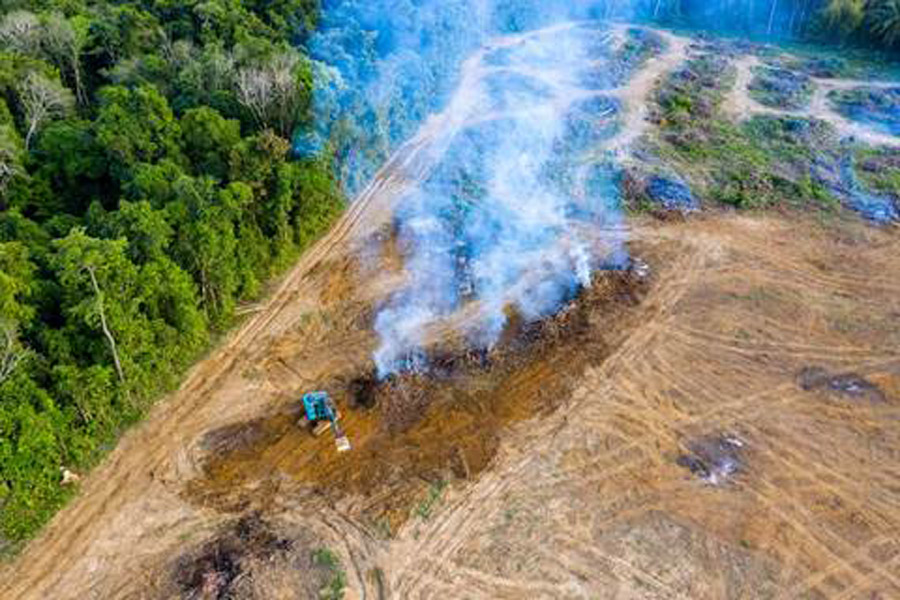The rainforests of the Amazon basin are full of mysteries. Some have puzzled researchers for centuries, while others have come to light only recently. One such example of the latter are the “circles of mystery”.
Recent research has uncovered a series of straight, square, and ring-like ditches scattered throughout the Brazilian and Bolivian rainforest. These purpose of these man-made structures, whether they were used for drainage, defense, or ceremonial reasons, is a tantalizingly unanswered question. But they are certainly very old.
Did prehistoric people alter the landscape of the Amazon long before the Europeans arrived? The culture of such people is relatively unknown before the West reached the Americas in 1492. And two rival theories have emerged to explain these ancient earthworks, splitting the research community.
One theory is that the people of Amazon had a very limited impact on the landscape of the forest, altering it very little with their presence. The contrasting theory is that pre-Columbian people practiced their own form of slash-and-burn, with the damage to the forest healing after the European invasion.
But for now there are many more questions than answers.
Man-Made Brazilian Ditches
Following the destructive mass deforestation in the region due to the Amazon Colonization Project in the 1980s, straight, square, and ring-like ditches were discovered in multiple locations in the rainforest. With more finds being reported now that researchers know what to look for, these sites now number in the thousands.

Of particular interest is a region of 5,000 square miles (13,000 square km) in Brazil with around 450 circular ditches dug out of the soil, seemingly appearing wherever rainforest was cleared. As they were circular, they did not appear to be drainage channels. Could they be for defense?
Most of the ditches were around 30 feet (9 m) wide and 10 feet (3 m) deep. Alongside the ditches, walls rising up to 3 feet (1 m) are commonly found. However some structures are much larger, with one of the largest ring ditches having a huge diameter of 1,000 feet (305 m).
It seems hard to provide an explanation for these structures other than as a defensive fortification, despite the haphazard placement of the earthworks and the limited protection these low walls and structures seem to provide. One other piece of evidence supports this theory, as many of the circular earthworks are found on flat areas of high ground, which would make natural defensive focal points.
However, some other researchers suggest that they were used for channeling water and irrigation, as most of the ditches were found near a natural water source. In a paper published in the journal Antiquity in 2010, a team of researchers came up with yet another theory, stating that on the basis of the layout of the ditches, it could be inferred that they had a ceremonial function.
A number of archaeologists, including Sanna Saunaluoma from the University of Turku in Finland and Denise Schaan, a Brazilian specialist on Amazonian archaeology, support this theory. They believe that the groups of people gathered near these sites to celebrate various important annual events like fruiting seasons.
There was also a possibility that the people gathered for other reasons, such as marriages, births, and even deaths. Smashed vessels discovered near such sites during excavations may have been used to store food and drink in preparation for the events.
How Old Are They?
Until recently it had been assumed that the mysterious Brazilian ditches dated back to around 200 AD. However, some of the latest studies reveal that the earthworks are actually much older.
According to John Francis Carson, a postdoctoral researcher from the University of Reading in the United Kingdom, the sediment cores taken from two lakes near the earthwork sites show that they hold charcoal of long-ago fires and ancient pollen grains. Such findings could date back to the late Neolithic about 6,000 years ago.
- Olmec Civilization: Their Rise, Culture and Decline
- Cahokia Mounds: The Largest Ancient City in North America
However, some results show that the oldest sediments were not from the rainforest at all. Instead, they suggest that the landscape that existed before 2,000 to 3,000 years ago more closely resembled Africa’s savannah rather than the lush rainforest of the Amazon. It seems that the creators of the Brazilian ditches had carved them before the rainforest ever arrived.

The dating and discovery of the mysterious ditches in the Brazilian regions reveal a lot about the culture that existed in the Amazon region thousands of years ago. While the previous studies suggested that the area was only suitable for impermanent and small villages, these earthworks now reveal the existence of complex societies in the Amazon with advanced and rich cultures, now lost.
Questions Answered
The discovery of these mysterious ditches may have posed many new questions, but they have solved some mysteries as well. The ditches are clearly man-made and are older than the Amazon rainforests, pointing to a far more sophisticated pre-rainforest culture than had been previously though.
These structures were formed using only stone tools, which at first glance would suggest the need for a significant labor force. However this appears to be incorrect, and very few people were actually required in order to construct the structures.
Moreover, plant remains commonly found at the sites show that the population that existed at that time survived by cultivating maize. The presence of agriculture at this time poses an interesting thought: was the modern Amazon rainforest therefore the wild result of such agriculture, that is, was it partially man-made?
There are undoubtedly many more such earthworks in the remaining rainforest that are yet to be discovered by archaeologists. Who knows what else we may learn about these elusive people, who grew crops in Brazil when the land looked so very different.
Top Image: Ditches In Fazenda Colorada, Brazil, uncovered by deforestation. Source: Sanna Saunaluoma / CC BY-SA 3.0; Neil Palmer/CIAT / CC BY-SA 2.0.
By Bipin Dimri